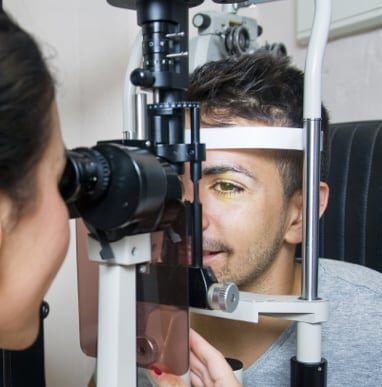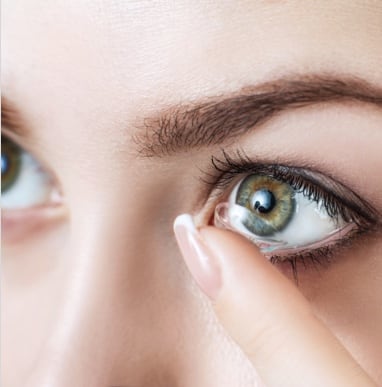If you’ve ever suddenly felt dizzy, disoriented, or overwhelmed by visual tasks, you’re not alone. For some, these symptoms begin gradually, but for others, they can appear out of nowhere. One often-overlooked cause of sudden, persistent symptoms like these is binocular vision dysfunction (BVD).
BVD can be difficult to recognize because its symptoms mimic other conditions, from anxiety to migraines to balance issues. But when your eyes aren’t working together properly, even everyday tasks like reading, driving, or walking through a crowded space can become exhausting.
What Is BVD?
Binocular vision dysfunction (BVD) happens when your eyes are slightly misaligned. Even a small misalignment can interfere with how your brain combines visual information from each eye. This mismatch can lead to symptoms like dizziness, eye strain, headaches, or difficulty focusing, especially during activities that require precise visual coordination.
Because BVD symptoms overlap with other common conditions, it can often go undiagnosed without targeted testing.
How Does BVD Start?
BVD can be caused by developmental causes, trauma-related onset, or gradual changes over time. Recognizing how and when symptoms begin can help uncover underlying issues with eye alignment that may have gone unnoticed.
Developmental Causes
Some people are born with slight misalignments that don’t cause symptoms right away. Over time, the brain’s effort to correct this imbalance can lead to discomfort or visual fatigue, especially during reading or screen-heavy tasks.
Trauma-Related Onset
Head trauma, including concussions or accidents, can disrupt how the eyes and brain work together. Symptoms may begin shortly after injury, even if no vision problems were noticed beforehand.
Gradual Changes
Eye muscle fatigue, aging, or increased visual stress can gradually affect alignment. For some people, these slow shifts result in a sudden “tipping point” where symptoms become noticeable or disruptive.
Can BVD Come on Suddenly?
Yes, binocular vision dysfunction can begin suddenly—even if the misalignment has existed for years. Often, the brain compensates until fatigue, stress, injury, or visual demands push it past its limits. When this happens, symptoms can escalate quickly.
You may find that everyday activities like working on a screen, driving, or reading suddenly feel uncomfortable or disorienting. This shift often prompts people to seek help.

Common Warning Signs & Symptoms
Symptoms of BVD can be physical, visual, or cognitive and they often overlap, making the condition difficult to identify without a comprehensive exam.
Symptoms of BVD can vary but often include:
- Blurry or double vision
- Light sensitivity, especially in dim environments
- Trouble focusing on words or images on screens and pages
- Headaches and neck or shoulder tension
- Dizziness, motion sickness, or difficulty maintaining balance
- Skipping lines or losing your place while reading
- Fatigue or difficulty concentrating during visual tasks
- Misjudging distances or struggling with depth perception
- Seeing words float, shift, or blur during reading
These symptoms may be constant or come and go, often intensifying with visual concentration or movement.
How Do You Treat BVD?
Neurolens
Neurolens uses contoured prism technology to correct eye misalignment and relieve pressure on the trigeminal nerve, which is closely connected to symptoms like headaches, eye strain, and dizziness.
Prism Lenses
Prism lenses shift visual input so the eyes can align images more comfortably. They reduce the effort your brain needs to merge two images into one, easing strain and improving clarity.
Vision Therapy
Vision therapy is a structured program of guided exercises that retrain the eyes and brain to work together. It’s especially useful for people whose visual systems need long-term support, including those with a history of head trauma or ongoing eye coordination challenges.
Why Diagnosis Matters
BVD is often misdiagnosed or overlooked entirely because its symptoms mimic other common conditions such as migraines, anxiety disorders, neck strain, or motion sickness. Many patients go through multiple healthcare providers before discovering that the root cause of their discomfort is visual in nature.
Identifying binocular vision dysfunction requires specific diagnostic tools and clinical experience. Not all eye care clinics are able to offer comprehensive testing and therapies, such as vision therapy, to treat this condition. Having access to a clinic that understands BVD means you’re more likely to get the answers and care you need.
Get Personalized Care
Sudden visual symptoms can be unsettling, but they’re also manageable with the right support. At Vision Care Center, we believe that understanding your vision begins with understanding you. Our team takes the time to listen, learn your needs, and tailor your care accordingly to help you feel seen, supported, and truly understood throughout your care journey.
If you’re noticing sudden changes in your vision or experiencing unexplained discomfort, book an appointment and we can assess if you have binocular vision issues and offer personalized solutions to help you feel more comfortable and confident in your everyday life.












